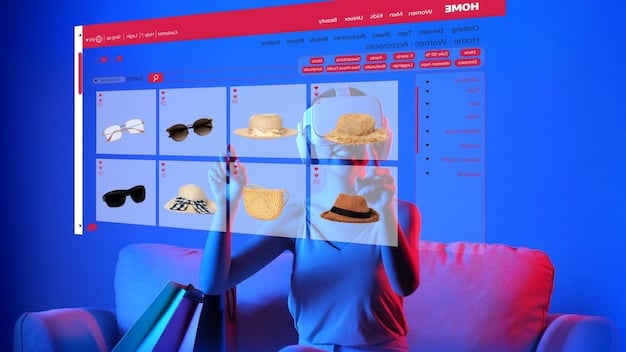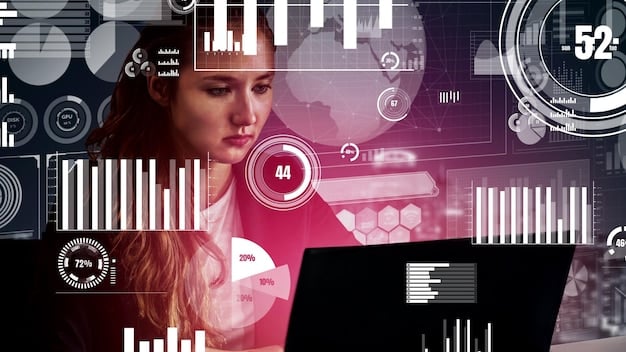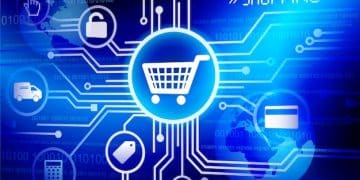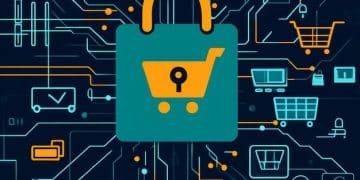Unlock Hidden Revenue: E-commerce Personalization Techniques for 2025

Unlock Hidden Revenue: Advanced E-commerce Personalization Techniques for 2025 reveals innovative strategies for businesses to enhance customer experiences and boost sales through targeted personalization. This includes AI-driven product recommendations, dynamic content optimization, and predictive analytics to tailor online shopping journeys.
The e-commerce landscape is constantly evolving, and in 2025, generic customer experiences simply won’t cut it. To thrive, businesses must focus on unlock hidden revenue: advanced e-commerce personalization techniques for 2025. This involves understanding individual customer preferences and tailoring their shopping journey accordingly.
Are you ready to discover the strategies that will set your e-commerce business apart in 2025? Let’s explore the personalization techniques that will drive revenue growth and customer loyalty.
Understanding the Power of E-commerce Personalization for Revenue Growth
E-commerce personalization goes beyond simply adding a customer’s name to an email. It involves leveraging data and technology to create highly relevant and engaging experiences. Unlock hidden revenue: advanced e-commerce personalization techniques for 2025 are crucial for businesses looking to maximize their profits. Let’s delve into why personalization is so impactful.
Why Personalization Drives Revenue
Personalization enhances the shopping experience by making it more relevant and enjoyable for each customer. This leads to increased engagement, higher conversion rates, and greater customer loyalty. By understanding customer behavior and preferences, businesses can offer targeted products, content, and offers.
Key Benefits of E-commerce Personalization
- Increased Conversion Rates: Personalized product recommendations and offers drive more sales.
- Improved Customer Loyalty: Tailored experiences create stronger customer relationships.
- Higher Average Order Value: Personalized recommendations encourage customers to buy more.
- Enhanced Customer Engagement: Relevant content and offers keep customers coming back.
E-commerce personalization is not just a trend; it’s a necessity for businesses looking to thrive in 2025. By focusing on creating unique and relevant experiences for each customer, you can unlock hidden revenue: advanced e-commerce personalization techniques for 2025 and achieve sustainable growth.
AI-Driven Product Recommendations: A Cornerstone of Personalization
Artificial intelligence (AI) is revolutionizing e-commerce personalization. AI-driven product recommendations are a powerful way to unlock hidden revenue: advanced e-commerce personalization techniques for 2025. By analyzing customer data and behavior, AI algorithms can predict what products a customer is most likely to buy. Let’s explore how AI is transforming product recommendations.

How AI Algorithms Work
AI algorithms use machine learning to analyze vast amounts of data and identify patterns. These algorithms can consider factors such as browsing history, purchase history, demographics, and even real-time behavior to make personalized product recommendations. The more data the algorithm has, the more accurate the recommendations become.
Examples of AI-Driven Product Recommendations
- “Customers who bought this also bought…”
- “Recommended for you based on your browsing history…”
- “Complete the look with these complementary items…”
- “Personalized offers and discounts based on your past purchases…”
AI-driven product recommendations are a highly effective way to unlock hidden revenue: advanced e-commerce personalization techniques for 2025. By leveraging the power of AI, businesses can create more relevant and engaging shopping experiences, driving sales and customer loyalty.
Dynamic Content Optimization: Tailoring Experiences in Real-Time
Dynamic content optimization (DCO) involves tailoring website content to each individual visitor in real-time. This is a crucial aspect of unlock hidden revenue: advanced e-commerce personalization techniques for 2025. DCO uses data and technology to personalize the content that a visitor sees, based on their behavior, preferences, and context.
Personalizing Website Content
DCO allows businesses to personalize various types of website content, including product listings, banners, headlines, and calls-to-action. By tailoring the content to each visitor, businesses can increase engagement, conversion rates, and revenue.
Implementing Dynamic Content Optimization
To implement DCO, businesses need to collect and analyze data about their visitors. This data can include demographics, browsing history, purchase history, location, and device type. Once the data is collected, it can be used to create personalized content variations that are shown to different visitors.

Dynamic content optimization is a powerful way to unlock hidden revenue: advanced e-commerce personalization techniques for 2025. By tailoring the content that visitors see, businesses can create more relevant and engaging experiences, driving sales and customer loyalty.
Predictive Analytics for Proactive Personalization
Predictive analytics uses data and statistical techniques to forecast future outcomes. In e-commerce, predictive analytics can be used to unlock hidden revenue: advanced e-commerce personalization techniques for 2025 by anticipating customer needs and behaviors, allowing for proactive personalization. Let’s explore how predictive analytics can be used to enhance the customer experience.
Forecasting Customer Behavior
Predictive analytics algorithms analyze historical data to identify patterns and trends. These algorithms can forecast customer behavior, such as which products a customer is likely to buy, when they are likely to make a purchase, and how much they are likely to spend. This information can be used to personalize the customer experience and increase sales.
Examples of Predictive Analytics in E-commerce
- Personalized Email Campaigns: Sending targeted email offers based on predicted purchase behavior.
- Dynamic Pricing: Adjusting prices in real-time based on predicted demand.
- Inventory Management: Optimizing inventory levels based on predicted sales.
- Fraud Detection: Identifying and preventing fraudulent transactions based on predicted patterns.
By leveraging predictive analytics, businesses can unlock hidden revenue: advanced e-commerce personalization techniques for 2025 and create more personalized and effective e-commerce experiences.
Personalized Customer Service: Enhancing the Overall Experience
Personalized customer service is an essential part of any successful e-commerce strategy. It involves tailoring customer service interactions to each individual customer, based on their needs and preferences. Improving customer service is one method to unlock hidden revenue: advanced e-commerce personalization techniques for 2025. Let’s dive into how customer service can be personalizing for maximum impact.
Tailoring Customer Interactions
Personalized customer service can include providing tailored recommendations, offering proactive support, and addressing customer concerns in a personalized manner. By understanding each customer’s unique needs, businesses can create more positive and satisfying customer service experiences.
Strategies for Personalized Customer Service
- Using customer data to personalize support interactions.
- Offering proactive support based on customer behavior.
- Providing tailored recommendations and solutions.
- Addressing customer concerns in a personalized and empathetic manner.
Businesses that invest in personalized customer service can unlock hidden revenue: advanced e-commerce personalization techniques for 2025. This leads to improved customer satisfaction, increased loyalty, and higher sales.
The Future of E-commerce Personalization
As technology continues to advance, the future of e-commerce personalization looks brighter than ever. New technologies, such as augmented reality (AR) and virtual reality (VR), are opening up new possibilities for creating personalized shopping experiences. To remain at the forefront, companies are working hard to unlock hidden revenue: advanced e-commerce personalization techniques for 2025.
Emerging Technologies and Personalization
AR can be used to allow customers to virtually try on clothes or see how furniture would look in their homes. VR can be used to create immersive shopping experiences that transport customers to virtual stores. These technologies can be used to create highly personalized and engaging shopping experiences, driving sales and customer loyalty.
Preparing for the Future
To prepare for the future of e-commerce personalization, businesses need to invest in data and technology. They need to collect and analyze data about their customers, and they need to implement the technologies that will allow them to create personalized experiences. By doing so, they can unlock hidden revenue: advanced e-commerce personalization techniques for 2025 and stay ahead of the competition.
| Key Point | Brief Description |
|---|---|
| 💡 AI-Driven Recommendations | Using AI to suggest products customers are likely to buy. |
| 🎯 Dynamic Content | Tailoring website content in real-time based on user behavior. |
| 📈 Predictive Analytics | Forecasting customer behavior to personalize marketing efforts. |
| 📞 Personalized Support | Customizing customer service based on individual needs. |
Frequently Asked Questions
E-commerce personalization leads to increased conversion rates, improved customer loyalty, higher average order value, and enhanced customer engagement, all contributing to business financial growth. It helps unlock hidden revenue: advanced e-commerce personalization techniques for 2025.
AI algorithms analyze vast amounts of data to predict what products a customer is most likely to buy, leading to more relevant and effective recommendations, thus increasing sales.
DCO involves tailoring website content to each individual visitor in real-time. It enhances their experience by unlocking hidden revenue: advanced e-commerce personalization techniques for 2025 tailored to them.
Predictive analytics can forecast customer behavior, allowing businesses to send targeted email offers, adjust prices in real-time, optimize inventory levels, and detect fraudulent transactions.
Personalized customer service can enhance the overall experience by tailoring interactions to individual customer needs and preferences and can help to unlock hidden revenue: advanced e-commerce personalization techniques for 2025.
Conclusion
In 2025, e-commerce personalization will be more critical than ever. Companies which unlock hidden revenue: advanced e-commerce personalization techniques for 2025 will have a significantly better opportunity to thrive in coming years.
By investing in data, technology, and personalized experiences, businesses can create stronger customer relationships, drive sales, and stay ahead of the competition, ensuring long-term financial success.





